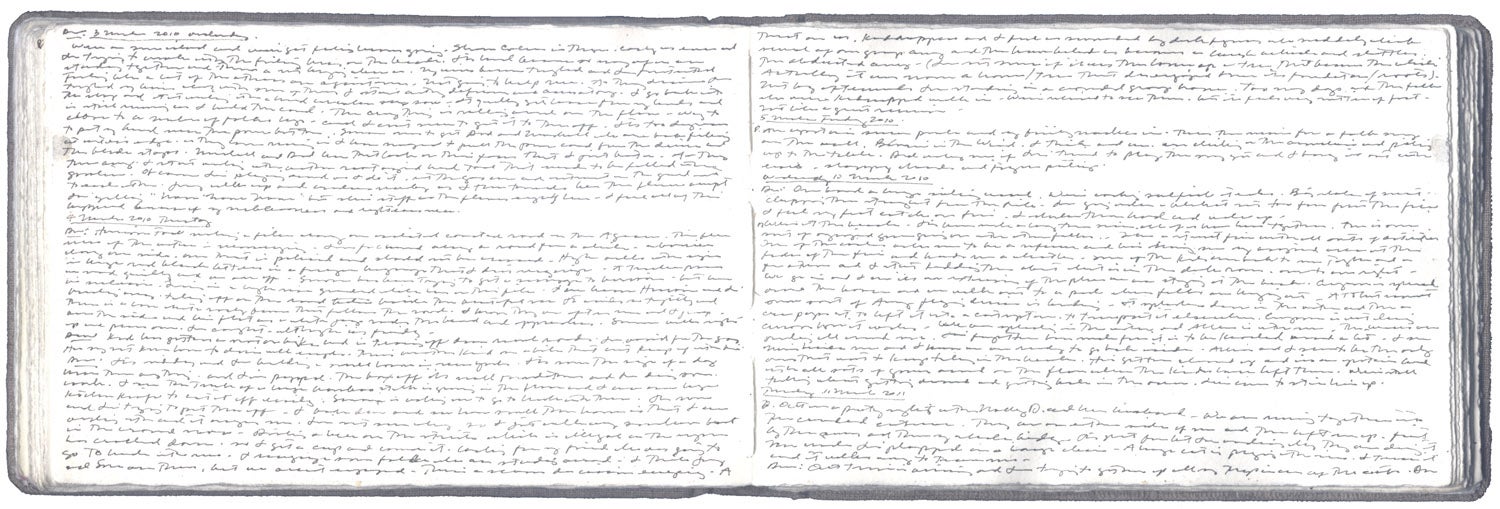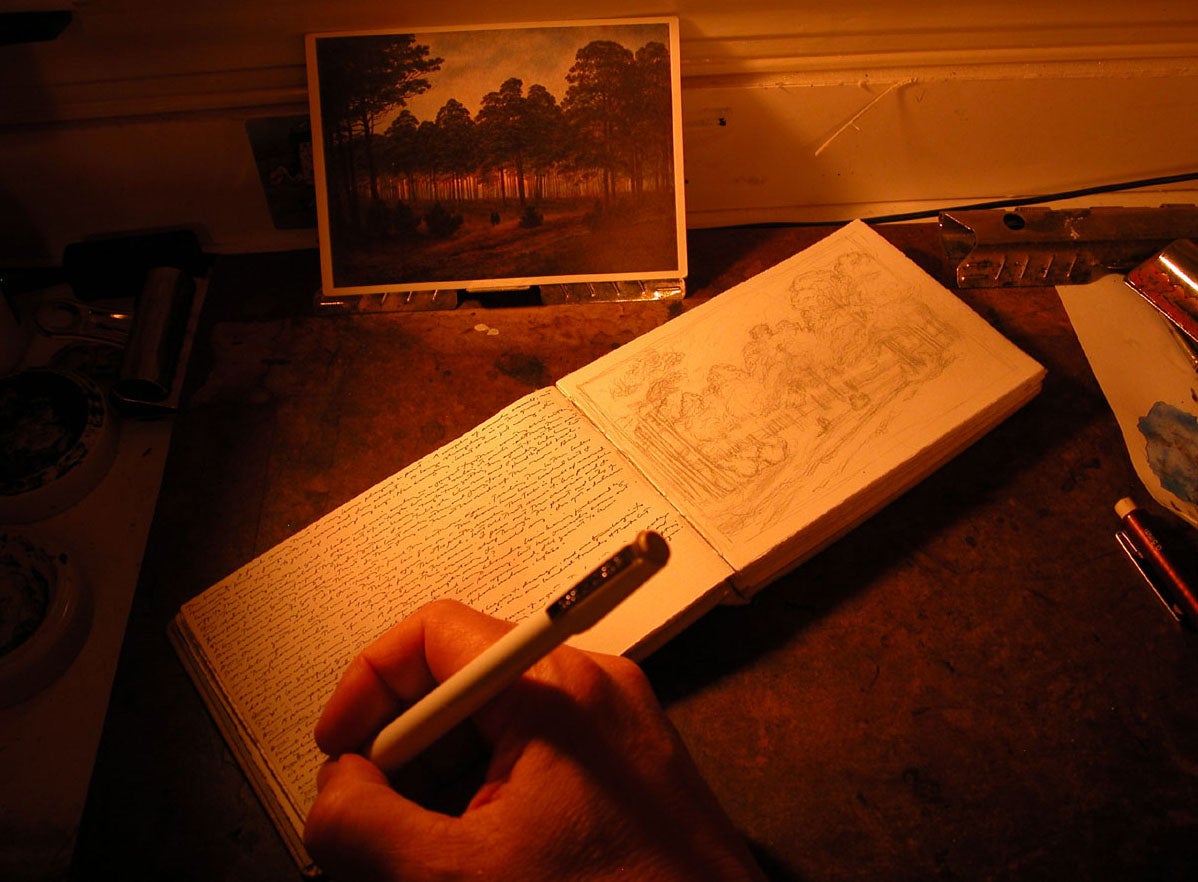
Note: The following discussion is adapted from correspondence with composer Roger Reynolds, whose music I admire. I thank Roger for his interest in my art and for his engaging questions.
Q: How does your writing function? Is it an expressive act more than a literally 'communicative' act, so that it would not matter if it were intelligible to others, or even to yourself?
A: I try to keep my script legible, at least to myself. There was a brief period during the earliest years of my journal keeping in which I wrote without concern for reading what I had written. I considered the exercise a strategy for breaking my ways of note taking that felt restrictive at the time (see online journal entry, Journal as Lifeline.) As my notehand evolved, it developed into a tool for inscribing thoughts quickly, compactly, and privately. At the speed I write, occasionally I'll slip into an unreadable passage. I would prefer it otherwise. However, I do think of the writing as abstract form. It is certainly a practice of miniature gestures that is completely outside the purpose of composing language; a kind of drawing practice. Sustained discipline is required to write in this way. In order to keep the rows of script parallel I balance the side of my hand along the lower edge of the paper working my way down the sheet incrementally from line to line. In a design sense, I'm also conscious of the page and the placement of my writing in relation to images even though the pictures and text rarely describe each other. In the end, I write primarily to record ideas and I endeavor to make the writing comprehensible to myself.
In my early journals I attempted to track my train of thought. With this exercise I intended to train myself to follow the words that came into my head as much as possible. These thoughts were often notes about my projects as they developed. However, my books have grown with me over the years, reflecting my abilities and interests, and my writing has become almost solely about recording dreams. I have cultivated my ability to remember these elusive phenomena and it has paid off (see on line journal entry for 25 December 2007.) My motive for dream recording is to keep in touch with my subconscious as manifested in dream symbols. When I transcribe my dreams, it is almost like taking dictation. This approach seems far more direct in its ability to show me what is going on beneath my surface than the rambling train of thought I scribed during my early years of journaling. I can't make this dream stuff up. I may shape dreams into words and verbally describe the images and feelings that accompany them, but I have no control of the content. I like that.
I don't draw my dreams, although you might think I would want to. I have often imagined film would make the best visual adaptations of dreams as it is a more temporally structured medium. Writing down my dreams is perfectly effective for my purposes. And when the texts are placed alongside my drawings in the context of my notebook, the two threads become parallel perspectives coursing through my life. They rarely touch and give alternate vistas of who I am and how I live.
Q: What are you thinking about when you are writing?
A: Beyond my efforts to put the dream experience into words, there are numerous tracks of awareness that shift in and out of focus. The first thing I do when I wake is look over a small spiral bound book that I keep at my bedside. If I've managed to put down some dream notes overnight, I'm hoping that deciphering a few key words will trigger a clearer memory of the dream. As the notes are often written in a drowsy blur, they lean towards illegibility. Sometimes I can bring back the essences of the dream using the notes. Sometimes I can't. I usually reserve the first part of my early morning studio hours for my writing process. I am usually sitting at my table in front of the window and waking up; becoming aware of my surroundings. I am beginning to observe my subjects and occasionally I may break into quick watercolor study of something I notice that I want to get down in my journal. I am also distracted with chores; making coffee, feeding the cat, remembering the things I have to get done in the day ahead. These things can sometimes derail remembering the dream. Sometimes I pick up my guitar and run through a section of a song I'm trying to learn or stop to review my current crop of drawings, trying to decide which I will work on during the coming drawing session. A bit of maintenance on the Rapidograph pen that I use to write in my journal can also cause a detour; it's hard to keep the thin points working well. The written dream often takes shape slowly, and as the writing process continues, I begin to decipher what associations may be in the symbols appearing in my dream. I find there is almost always some connection between the feeling of the dream and the way I feel about some situation somewhere in my life. The dreams mirror my true feelings about things. They can often be unsettling because I know their essence is speaking the truth.
From the above description it's obvious that the process of inscribing my dreams is rarely the steady plotting of narrative in my journal. I spread myself out while I'm writing; my attention is in flux and tied to my intuition. This flow of focus is a useful part of the creative process. I'm convinced that all of the various inputs listed above (and many others) shade my language and influence the drift of my writing. I know transcriptions of my dreams can never be exact replications. My imagination intersects with everyday events; with reality. The resulting composition written in my journal is a picture of me at a certain fragment in time. And vice versa, I think my dreams and writing process shade the drawings as I begin work in my studio session. It's hard to say exactly why, but I feel the gossamer threads of the dreams permeate and weave the drawings together. As I begin to draw, I still have the dreams on my mind. Sometimes stray fragments of dreams percolate into my consciousness; I'll lightly inscribe these on my drawing in pencil, preserving the remembrance for later transfer to journal. (see online journal entry for 14 May 2009.)

The artist writing in his journal 10 July 2010. The pencil drawing is work in progress based on a postcard image of a painting by Caspar David Friedrich.